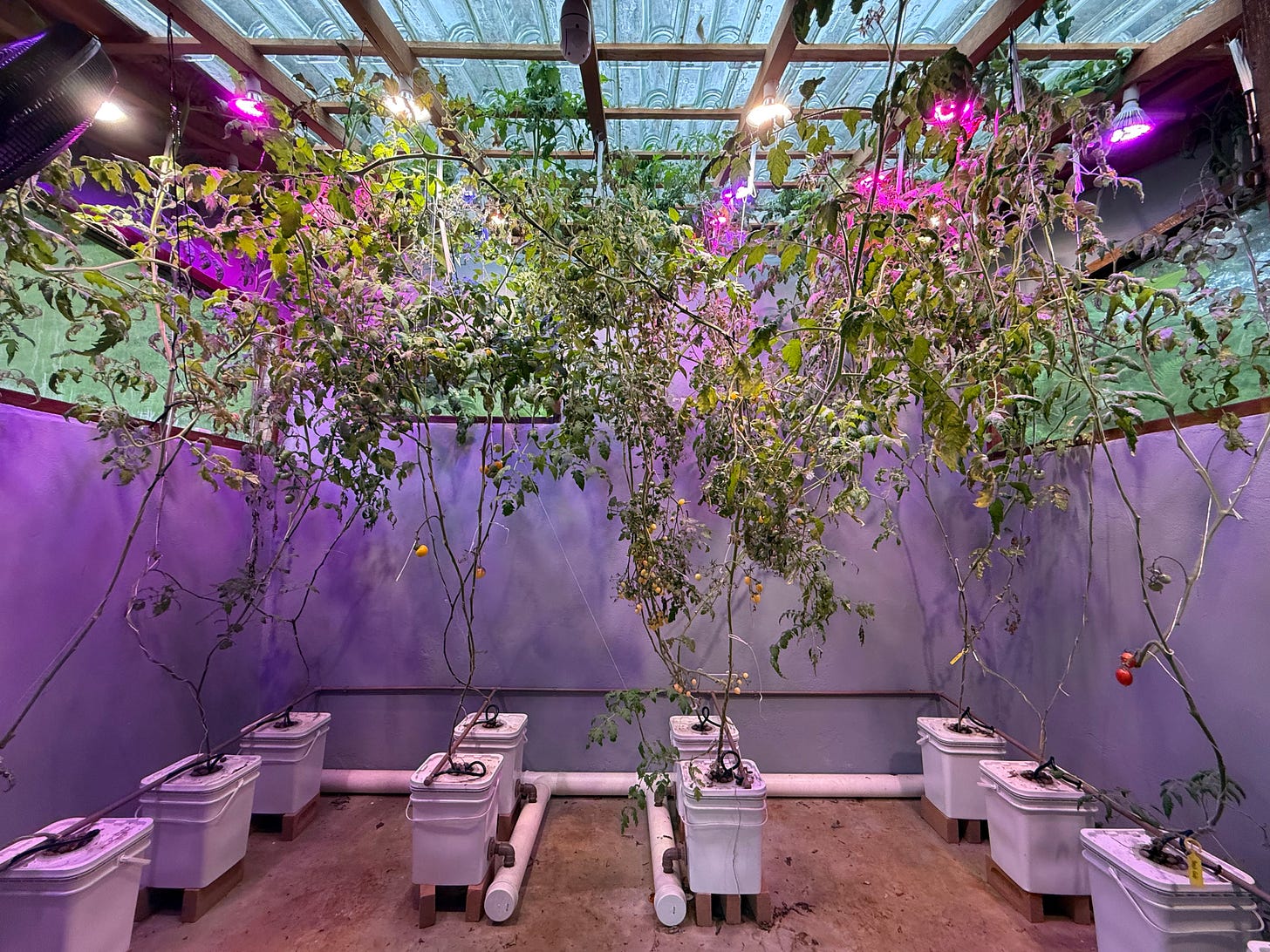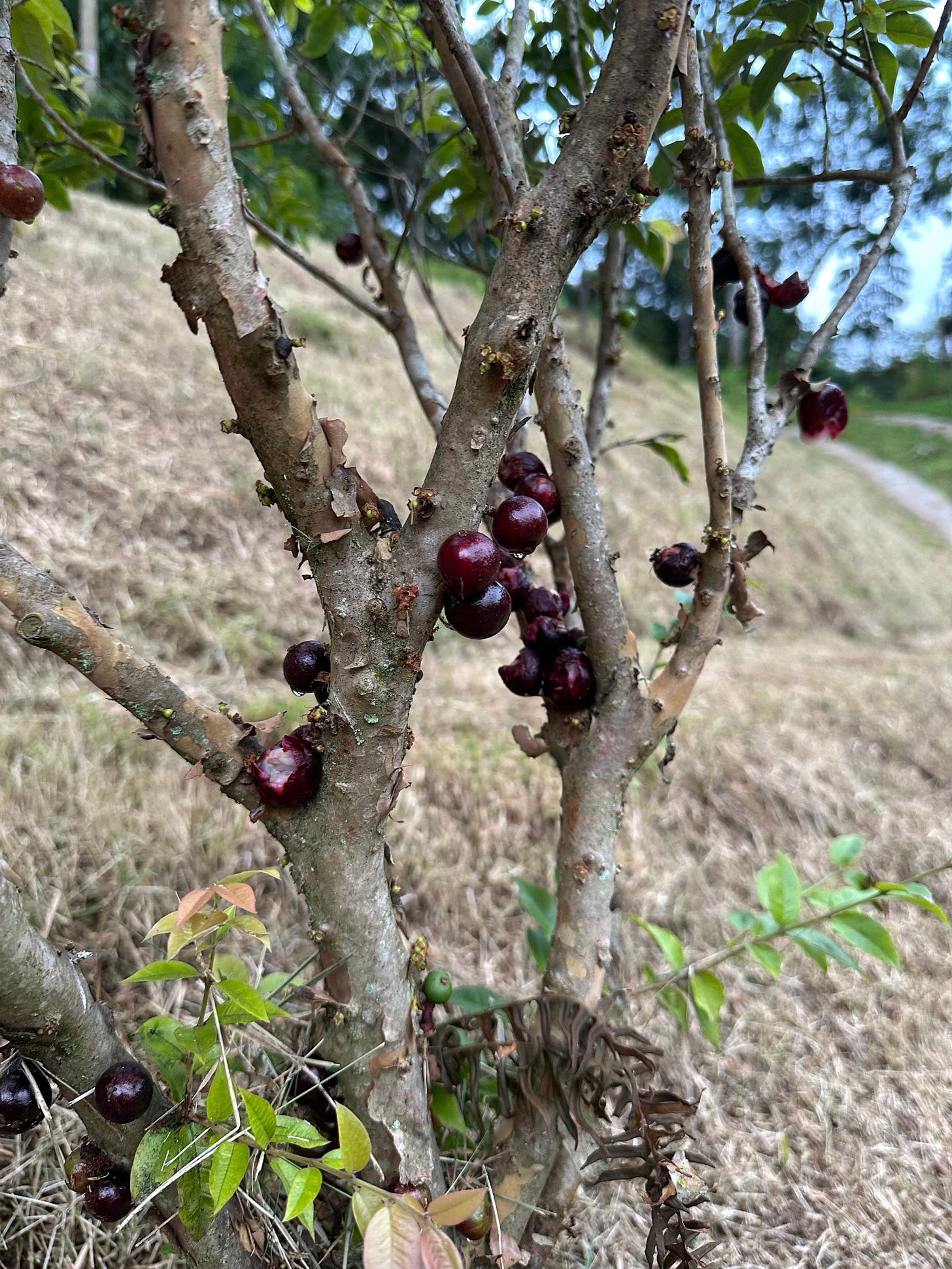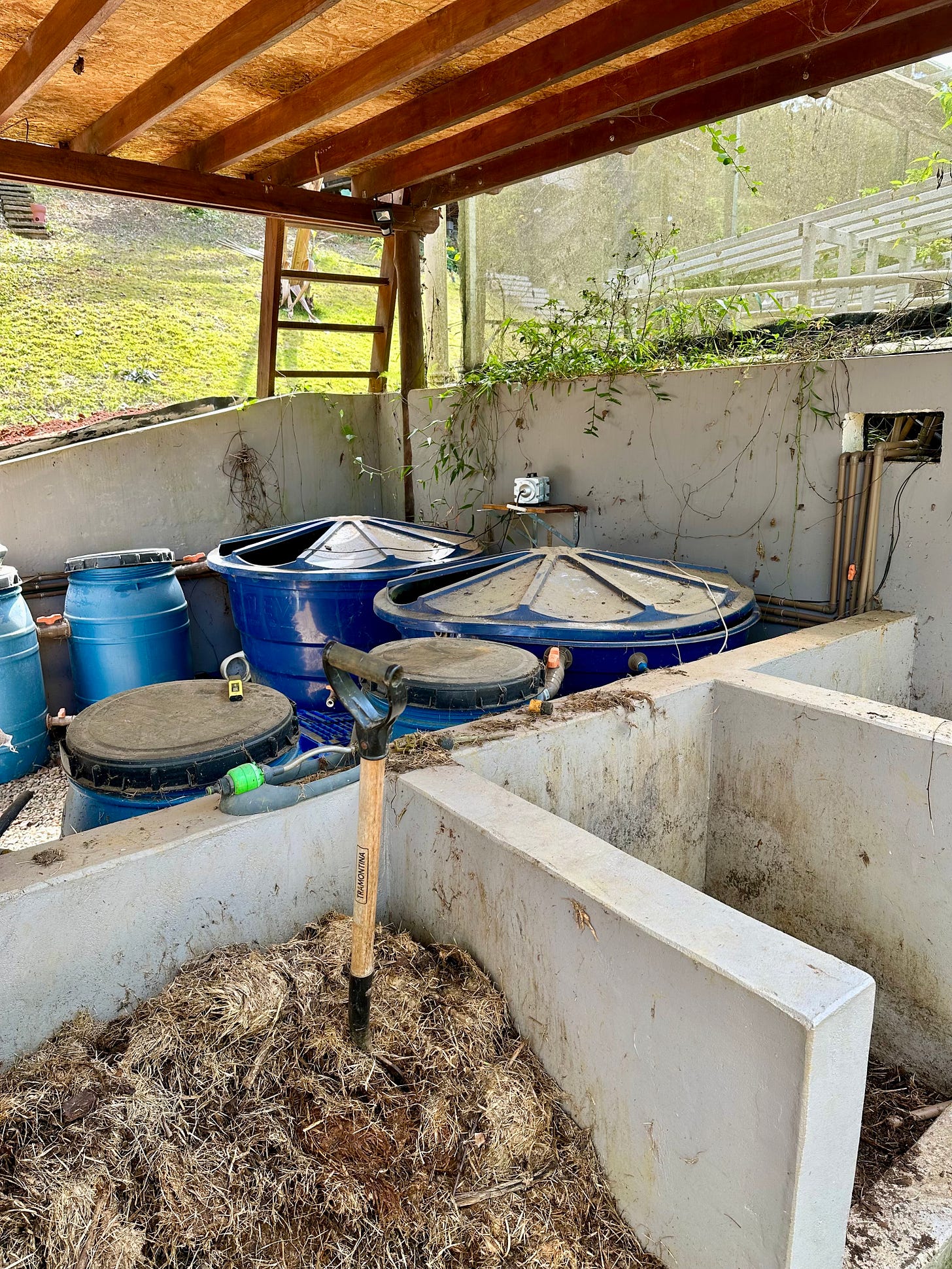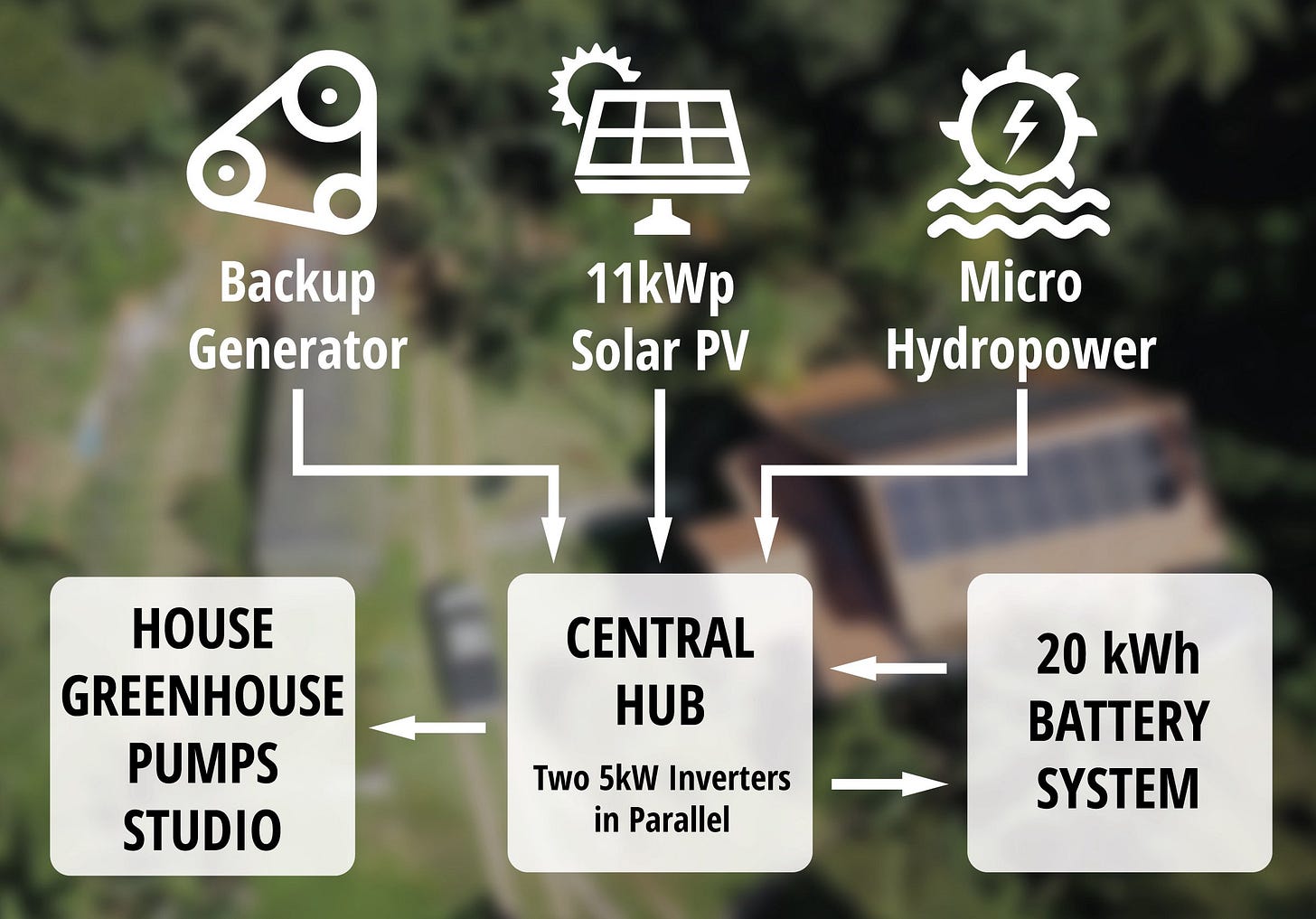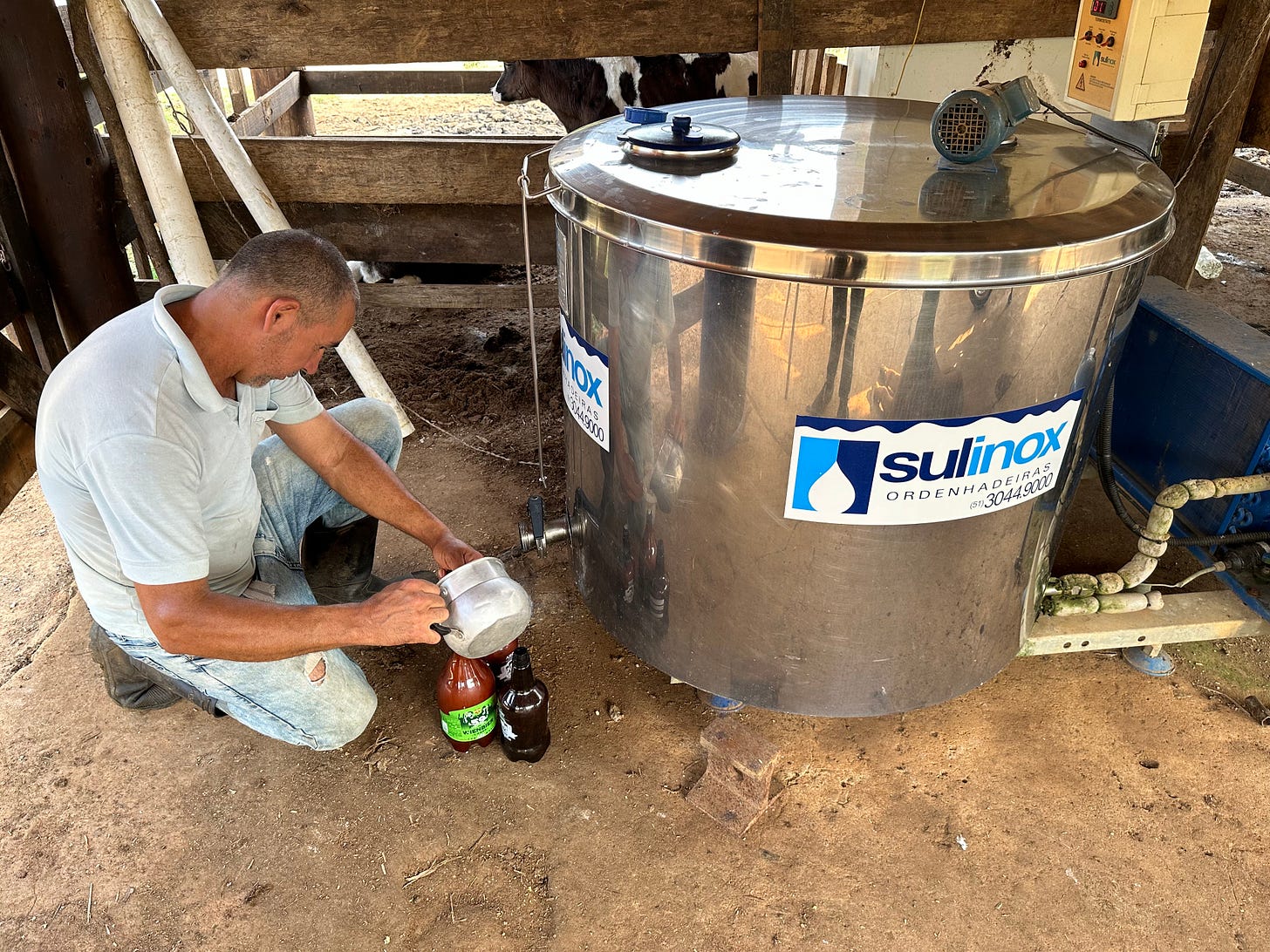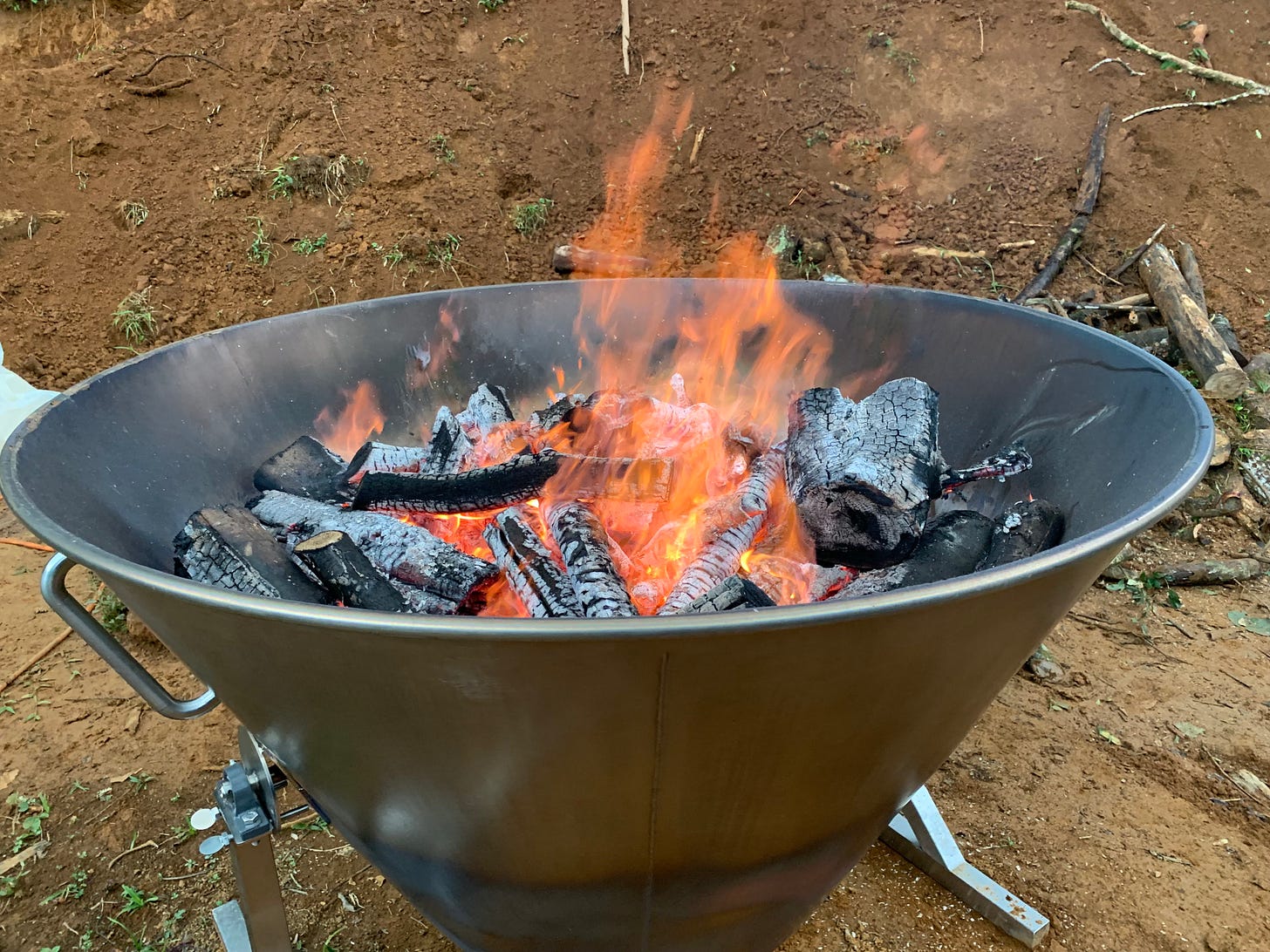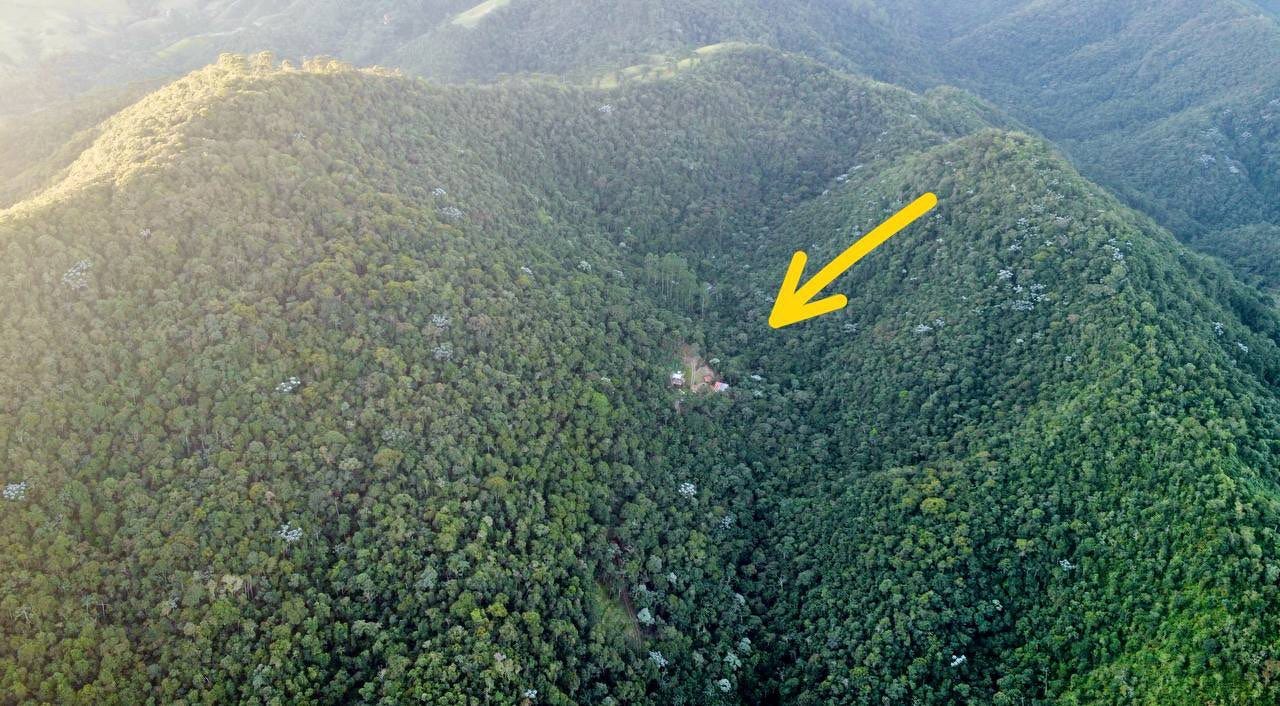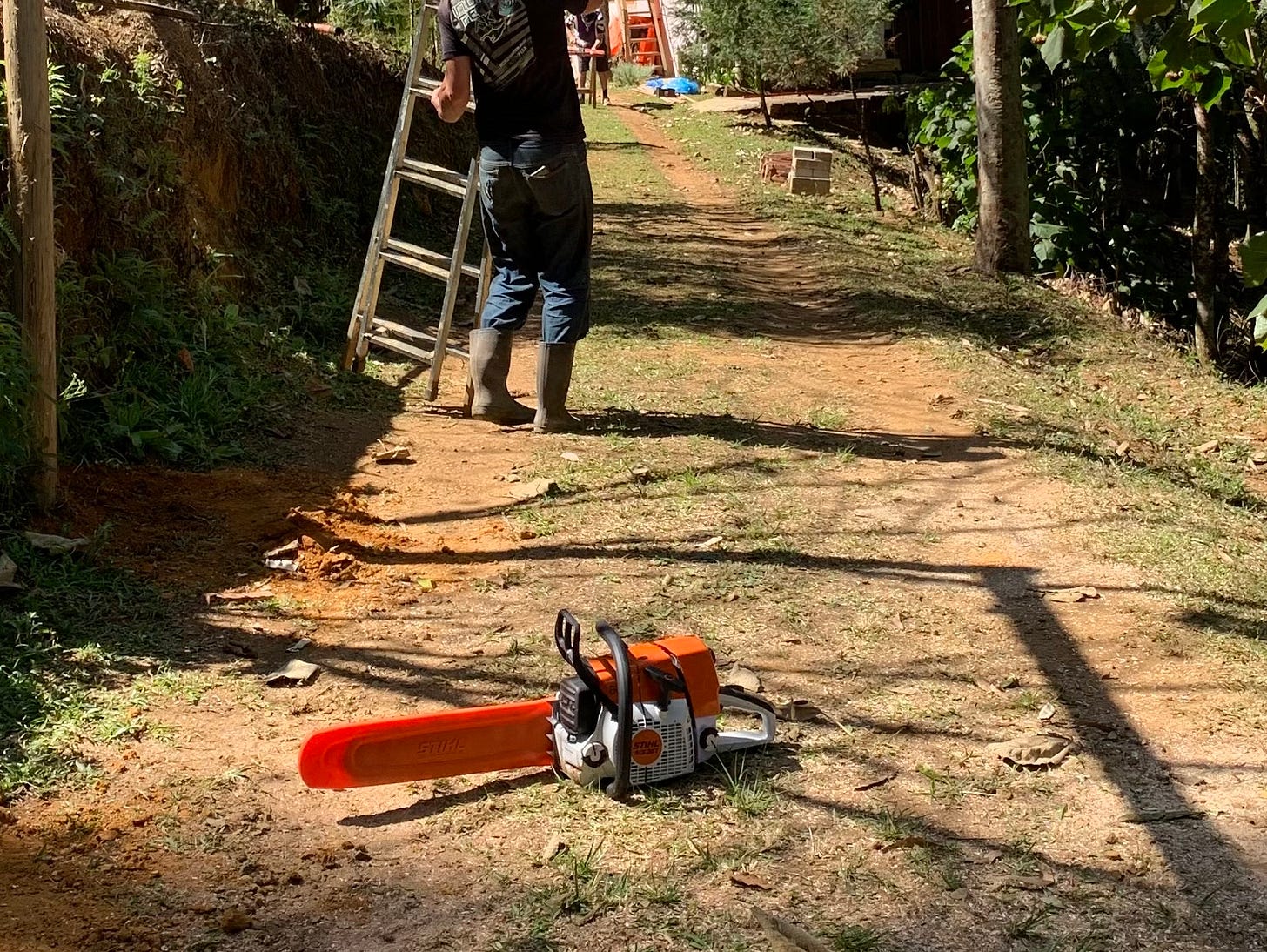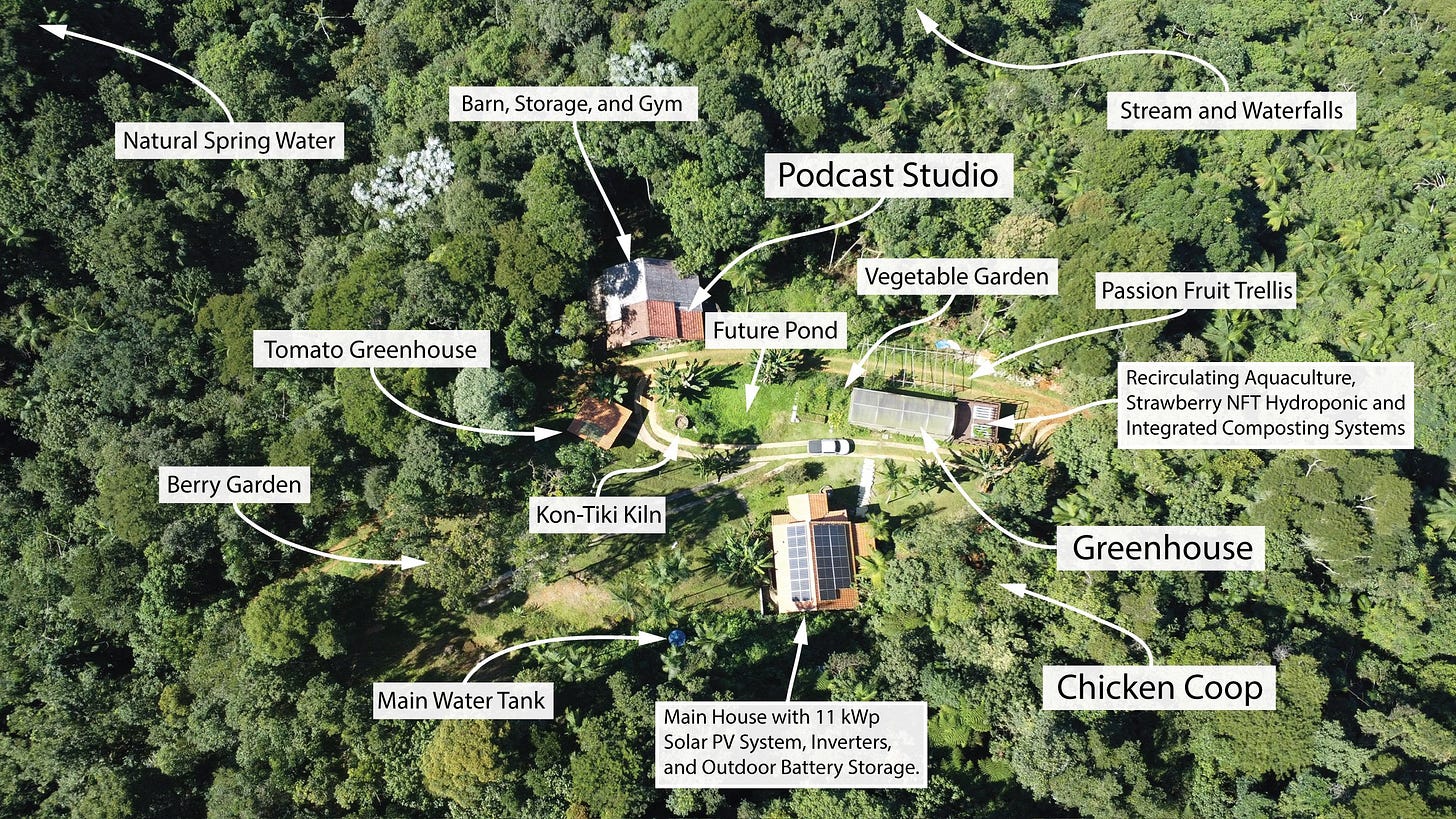I was just flying my drone over my land… and I thought: damn — I really built my own paradise here in the Brazilian jungle. Here are the 8 Pillars of Real Self-Sufficiency I live by — far from government overreach, societal collapse, and digital slavery.
1. FOOD 🍗
“You are what you eat.” Whoever first said it was absolutely right, because food is more than fuel. It shapes your body, your brain, your mood, your immunity, and ultimately your freedom. If you want sovereignty over your life, it starts with what’s on your plate.
Most of the food you find in supermarkets today isn’t really food. It’s processed, stripped of nutrients, pumped with preservatives, and grown in degraded soil. Even the meat and milk are compromised. Factory-farmed animals fed unnatural diets result in products with dangerously skewed omega-6 to omega-3 ratios, which drive inflammation and disease. Add in pesticide residues, seed oils, and synthetic additives, and you get the perfect recipe for physical and mental collapse, disguised as a “balanced diet.”
Almost every modern Western disease, from depression to diabetes, can be traced back to the gut. And the gut is shaped by what you feed it.
This is why food must be your number one priority if you’re serious about self-sufficiency, health, or survival. Growing your own food in a regenerative, permaculture-based system, or trading with others who do, is the only real solution.
As a scientist who has worked with human metabolism for years and studied the causal-loop relationships between dietary input and long-term well-being, I chose to walk the hard path. I left Europe — my family, friends, and even my frozen bank accounts — and moved to Brazil to build the life I believe in. I found a safe place surrounded by jungle, rich in natural resources, and began reclaiming control over my own food and health.
Today, I raise 30 Rhode Island Reds — strong, self-reliant chickens that lay around 20-25 eggs per day. They’re free-range, keeping snakes and spiders away from the house. I feed them homegrown corn, banana plant stalks, and local supplements. While jaguars and pumas occasionally claim one or two despite the electric fencing, I simply hatch more eggs and keep the cycle going.
I also built two greenhouses. The first (50m²) is dedicated to NFT hydroponics, where I grow strawberries, shishito peppers, blackberries and blueberries (in compost), safely shielded from the destructive jungle ants. The second (14m²) is for tomatoes, grown in Dutch bucket systems under sunlight and 20 solar-powered grow lights, yielding 2-4 pounds of heirloom tomatoes per day. I even started breeding my own tomato varieties.
I also constructed my own aquaculture system to raise trout and tilapia using mountain spring water, which then (being more nutrient-rich due to fish poop/pee) becomes as a fertilizer source for my greenhouse crops.
Beyond that, my land overflows with edibles that thrive in this environment. “Plagues” like sweet potato are a blessing, producing several kilos per plant, perfect for barter or storage. Physalis (golden berries) pop up everywhere and fetch premium prices abroad. Turmeric is invasive, yes, but I harvest and dry it, alongside chili, sweet paprika, black pepper, rosemary, oregano, and cumin. For this, I imported a Ninja 11-in-1 oven, which I also use to ferment yogurt from raw milk.
My food forest is expanding fast. I’ve planted over a dozen banana varieties, including rare types from pink to black. I’m growing mulberries, papayas, avocados, peaches, grapes, olives, lemons, oranges, and tropical species few people have even heard of. I’ve even started harvesting jabuticaba, one of my favorites — its sweet, grape-like fruit grows directly on the bark, straight from the trunk like something out of a fantasy novel.
Everything I grow is real, nutrient-dense, and free from chemicals. Some of it feeds my family, some feeds my animals, and some I trade for raw milk, meat, or organic cheese with local farmers.
Food is the foundation. Food is health. Food is sovereignty. And growing it yourself is the first act of true rebellion.
2. WATER 💦
Without water, there is no self-sufficiency. It’s not just about drinking — it’s about irrigation, animals, cleaning, aquaculture, and even energy.
The first step to living off-grid is identifying your primary water source:
Spring water is ideal — clean, pressurized, and often year-round
Groundwater can work, but always test for contaminants and ensure recharge stability
Rainwater can be excellent too, but it requires proper collection, filtration, and reliable storage
Surface water (creeks, ponds) may be usable if managed well, especially with filtration or for non-potable use
No matter what the source: Have a reservoir. Water storage = drought insurance. And invest in treatment or filtration systems, because polluted water is worse than no water.
In my case, I’m lucky. I have three natural untouched springs flowing directly from the mountain. There’s no one above me. That means:
No chlorine
No fluoride
No microplastics
No birth control residue or other pharmaceutical garbage
Just clean, chemical-free, pressurized mountain water. This water feeds everything: my house, my gardens, my chicken, and my aquaculture system (where I raise trout and tilapia).
That nutrient-rich fish water then gets channeled it into my NFT (Nutrient Film Technique) greenhouse, where strawberries and peppers grow like wildfire (and the solid waste goes right onto the composting systems).
Right now, I still use an electric pump to push water to my main tank. But I’m about to upgrade to a hydraulic ram pump, which is a pump that uses gravity and pressure from falling water to lift a portion of it uphill, without any electricity.
That means more efficiency, less energy use, and even less dependence on solar or batteries.
If you don’t control your own water, you’re not free. It’s that simple. You can live without power for a while, but not without water. And if your water is poisoned, everything else collapses.
3. ENERGY ⚡️
Without energy, self-sufficiency collapses. You can grow your own food, collect your own water, but without power for pumps, fridges, lights, or communication, you’re still dependent.
The best setup isn’t just going solar.
It’s about creating an energy mix that gives you reliability, day and night, rain or shine.
Micro-hydropower is ideal: if you have a steady stream or height drop, it gives you base-load electricity 24/7. No sun needed. No wind required. No fluctuations.
Solar is excellent for sunny areas, especially when paired with batteries and smart load timing.
Wind can be useful in the right environment, though it’s more complex.
Biogas (from food scraps, manure, or plant biomass) can fuel a generator and keep things running off-grid.
A hybrid system is key.
In my case, I run a hybrid microgrid built for real independence:
11 kWp solar PV system
Micro-hydropower turbine (powered by a 300 ft elevation drop from my springs)
Backup generator — rarely used, but always ready
20 kWh battery bank
All of it flows through a central hub of two 5 kW inverters in parallel, powering my house, my greenhouses, pumps, studio, and even Starlink. The result are: no bills, no outages during the rainy season, no worries. I generate power while others are stuck in the dark.
If you’re building your own system:
Start with what’s abundant in your area (sun, water, biomass)
Combine sources for stability
And size your batteries wisely — because energy storage is your security
4. COMMUNITY 🫂
You can go far alone, but you’ll go farther, safer, and saner with others. Self-sufficiency doesn’t mean isolation. It means independence within interdependence.
If you’re serious about off-grid or permaculture living, then find people.
Build shared projects
Create a micro-village
Pool resources, land, tools, skills, and labor
Reduce workload, increase security, and multiply your freedom
Surround yourself with people who know how to do things:
Grow food
Fix machines
Treat injuries
Build, hunt, trade, preserve
Because when things go sideways, people with degrees in marketing, HR, or gender studies won’t be the ones who keep you alive.
In my case, I live remotely — no direct neighbors. But within 20–30 minutes driving, I’ve built a network of farmers and homesteaders like this dairy farmer.
We trade regularly:
Eggs for milk
Seedlings for cheese
Labor for meat
Most of the food I don’t produce myself, I get directly from people who do — no middlemen. And most importantly: Each person brings a skill. And in a world where systems are breaking down, real-world skills are the new currency.
5. COMPOSTING 🪱
If you don’t build your soil, you’re just camping. Soil is everything. It’s your foundation for long-term abundance.
Modern agriculture has destroyed our topsoil layer, the most fertile part of the earth. Years of chemical farming, tillage, and surface runoff have stripped it of nutrients and life. What you often see today is dead dirt, not living soil.
If you want a thriving, disease-resistant, nutrient-dense food system, you need to restore the soil. That starts with composting, and goes far beyond dumping food scraps in a pile.
In my case, I do multi-level composting and bio-enhancement:
I run a Kon-Tiki Kiln to create biochar (a high-carbon charcoal)
I collect indigenous jungle microbes using bamboo tubes filled with cooked rice
I incubate and multiply those microbes in homemade bioreactors filled with water, sugar, and self-made papaya juice.
I mix the pulverized biochar, compost, and microbes to create terra preta, the legendary black soil once used by the indigenous peoples of the Amazon
I don’t just sustain my land, I regenerate it. And I go further:
I do wet composting as well, using the nutrient-rich brine as a fertilizer in my hydroponic systems
Nothing goes to waste; it all gets cycled back into the land
The results are healthy plants, nutrient-dense food, and microbial-rich soil that only gets better with time.
Composting turns your waste into gold… literally.
6. PRIVACY & LOCATION 📍
If the system crashes, and one day it will, location will decide your fate. Whether it’s a global economic collapse, a civil breakdown, or even a polar shift, being in the wrong place at the wrong time means you’re a target or a casualty.
Choose wisely.
Far enough from urban chaos
Remote enough to be off the radar
Accessible enough to still live and trade
Secure enough to defend
The perfect location isn’t a bunker; it’s a buffer zone between total isolation and total exposure.
In my case, I live at nearly 5,000 feet (1,500 meters) in the Brazilian highlands. To reach my land, you need all-wheel drive and more than just basic driving skills. It’s not a quick stop off the highway. That’s the point. It’s not convenient, it’s strategic.
There are no streetlights, no direct neighbors, no noise. Only jungle, elevation, and peace.
Privacy is protection. Remoteness is resilience. And when the shit hits the fan, I won’t be stuck in a traffic jam or waiting in a breadline.
I’ll be home with everything I need.
Build your sanctuary now. Later may be too late.
7. SKILLS & TOOLS 🛠️
In a world where systems are breaking down, real-world skills are the new currency. It’s not about what you studied or what title you hold, it’s about what you can do with your hands, your mind, and the tools you’ve got. If you can’t fix, build, grow, or repair, then someone owns your life. And no amount of theory will save you when the lights go out.
Luckily, this is the best time in history to learn. We have YouTube. We have AI. We have access to a near-infinite pool of knowledge and tutorials, and most of it is free. If you don’t know how to install a solar inverter, wire a battery, or build a chicken coop, you can learn it. The earlier you start, the more confident and capable you become.
I never imagined I’d be renovating houses, running plumbing, installing energy systems, or building greenhouses in the jungle. But here I am, because I had to. I figured it out. And the best part is, the more you solve problems, the more your confidence grows. Everything is learnable, and every skill adds to your freedom.
But skills alone aren’t enough. You need tools. Good tools. Essential tools. In my case, I couldn’t live without my chainsaw, my Kon-Tiki kiln for charcoal production, my water pumps (always have backups!), and my workshop full of wrenches, saws, electrical gear, and repair kits. Depending on your land, even small machinery, like a mini excavator or earth auger, can be a massive time-saver. Wherever you are, you’ll need the right equipment to get the job done, especially when there’s no one to call for help.
In short: the system wants you helpless. Useless. Trapped in convenience and dependence. But every tool you master and every skill you develop is one more chain broken. Self-sufficiency is built with your own two hands, one problem, one project, one solution at a time.
8. PERSISTENCE 💪🏻
Call it grit, discipline, or just pure stubbornness — without it, nothing else works. Building a self-sufficient life isn’t a weekend hobby or a summer retreat. It’s a full-on commitment. It’s waking up each day knowing there’s another problem to solve, another part to fix, another upgrade to plan. It’s like living in a real-life strategy game where every click is replaced by sweat, tools, and time. Only here, the outcome directly shapes your survival, your freedom, and your future.
Yes, you need tools. Yes, you need skills. But above all, you need persistence. You need the mental strength to keep going when it rains for two weeks straight, when the ants wipe out your seedlings again, when a jaguar kills almost all of your chickens, or when your water system malfunctions at 2 a.m. It’s not about comfort; it’s about conviction.
The drone photo I shared gives you a wide view of my land and my sub-projects. What you don’t see in that lush jungle landscape is how much of it started as nothing but wild terrain. Every path, every line of pipe, every fence post and greenhouse was built step-by-step. There’s still so much to do, and I do a bit more every single day.
What I’ve been building, and continue to build, is a long list of solutions to countless problems. It’s been a constant process of:
Solving humidity issues
Managing temperature fluctuations
Fixing accessibility and road erosion during the rainy season
Rebuilding soil quality and structure
Troubleshooting energy system inconsistencies
Fighting off plant pests and fungal outbreaks
Developing defense mechanisms against deadly snakes, spiders, jaguars, and pumas
Trying to outsmart the relentless plant-cutting ants
This lifestyle isn’t for people who give up. It’s for those who choose discomfort now so they’re not defenseless later. It’s for the modern-day adventurer. The type who wants to build a real legacy, not just consume one. The kind of person who dares to take control of life instead of outsourcing it to collapsing systems.
We haven’t seen a full economic collapse in our lifetime, but history tells us it’s coming — again. Every empire has fallen. Look at the global deficits, the inflation, the absurd money printing, the distraction wars, and the social engineering. It’s all pointing toward the same outcome. And when it happens, no government will save you. No delivery app, no welfare state, no comforting slogans.
You’re responsible. For yourself. For your family. For your future.
So, yes, get the tools. Learn the skills. Build the networks. But above all: keep going. The mindset to never stop improving, never stop solving, never stop building, that’s the real superpower. Because freedom isn’t something you’re given. It’s something you fight for. One day at a time.



